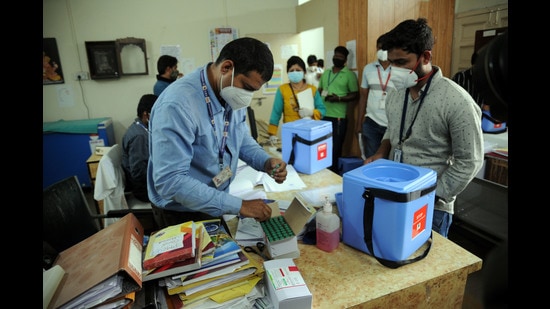Only a centralised vaccine management system will work
As production increases, there will also be a greater need for storage and distribution facilities, especially as the vaccination campaign has to reach rural areas. All these will be easier and efficient to implement in a centralised system where the partnering states could work on the last-mile execution of the vaccination drive.
India’s new vaccine policy, which comes into effect from May 1, will expand the population base to be vaccinated to anyone over 18 years. With the new strains of the mutated virus proving to be equally dangerous to the younger population, this is a welcome move on the part of the government. However, from now on, 50% of the supply from Indian manufacturers is earmarked for the Centre, which will continue its existing vaccination process, which offers free vaccinations for health care workers, frontline workers and for those over 45 years.

The remaining 50% of the supply is allocated for the open market that includes states, private hospitals and facilities that can administer the vaccine. Those between the ages of 18 and 45 have to get vaccinated from this lot. The central government has seemingly moved the responsibility of vaccinating the bulk of India’s young population on to the states and the private sector.
The new policy has many areas that require further clarity and fine-tuning, without which our vaccination drive will not be as smooth as we want it to be. Under the new policy, various state governments and private players will be competing with each other for procurement of vaccine from a limited number of vaccine manufacturers. Serum Institute of India (SII) has priced its vaccine, Covishield, at ₹400 for states and ₹600 for private players. Meanwhile, Covaxin has equivalent prices of ₹600 and ₹1,200 respectively.
With the Centre not putting in place any pricing regulations, other manufacturers, including possible new entrants, could create some amount of confusion in the market by offering a range of prices. All manufacturers will definitely be more inclined to sell to higher-paying private purchasers than to any of the state governments. The bigger states, with more purchasing power, may get preference over smaller ones. In these difficult times, everyone involved could use the time and resources spent on procurement negotiations, and processing orders on much more productive causes.
Ideally, the Centre should have created a centralised vaccine procurement and management system. The cumulative purchasing power of a single buyer would have enabled the lowest possible price for our population. The Centre should also have made efforts to provide the vaccine free of cost to everyone. All states are going through a massive financial crisis. It would have been easier for the Centre to raise additional revenues as it has a lot more flexibility in taxation and borrowing. Finance minister Nirmala Sitharaman had set aside ₹35,000 crore for vaccinations in the 2021 budget. Vaccinating the entire adult population will cost India ₹67,200 crore or 0.36 % of the Gross Domestic Product. The financial costs incurred as a result of the pandemic being prolonged have already proved to be much higher.
The government will have to drastically scale up the vaccination rate. As things stand now, it could take us years to vaccinate the entire adult population. Production capacity also has to be enhanced considerably. SII produces almost 2.4 million doses a day, and Bharat Biotech will produce around two million shortly. This is not enough to vaccinate the population quickly enough. In a recent letter to Prime Minister (PM) Narendra Modi, former PM Manmohan Singh suggested invoking compulsory licensing of vaccine technology, similar to what Israel has done, allowing other prospective manufacturers to make the vaccines, supporting them with funds and other concessions to encourage expansion of capacity.
As production increases, there will also be a greater need for storage and distribution facilities, especially as the vaccination campaign has to reach rural areas. All these will be easier and efficient to implement in a centralised system where the partnering states could work on the last-mile execution of the vaccination drive. Universal adult vaccination is the most effective means to protect our people. Getting our population inoculated against this deadly virus is the only way to recover and rebuild after this massive economic and social upheaval caused by the pandemic.
Anil K Antony is the national co-coordinator of the AICC social media and digital communications department and co-founder of PIIndia.org, a Covid-national action groupThe views expressed are personal





